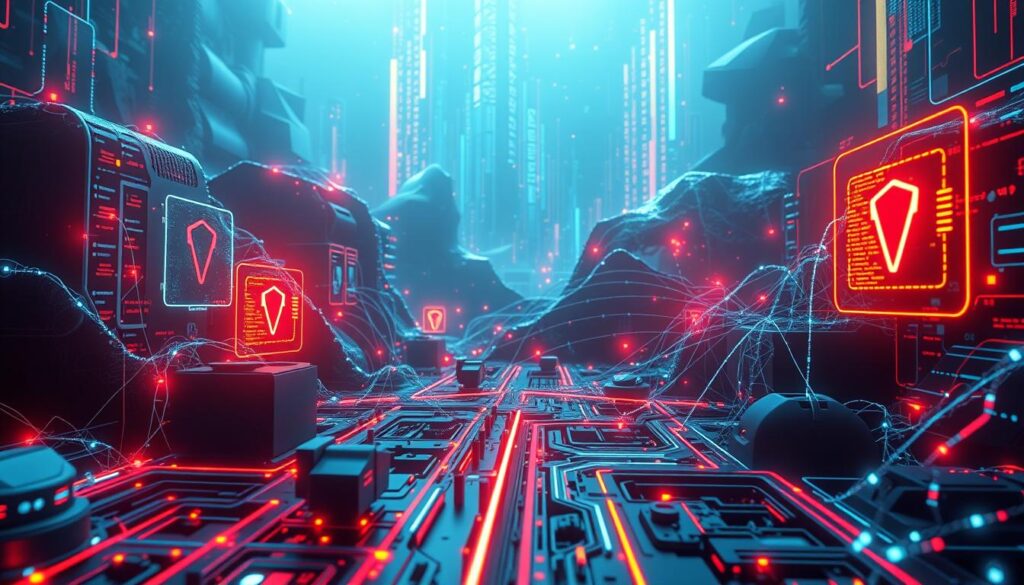Cyber attacks happen every 39 seconds on average. This rising trend makes finding good solutions urgent. Cybersecurity Automation is key, using AI to improve threat detection and response. It uses advanced data analysis and real-time monitoring to strengthen defenses against new threats.
AI-driven firewalls use machine learning to check network traffic. They spot unusual patterns and behaviors quickly. This lets them make firewall rule changes and catch zero-day threats early. AI also helps in access control, checking user behavior for insider threats or unauthorized access. It adjusts access rights based on current risk levels.
Using AI, companies can better detect threats, cut down on false alarms, and handle incidents faster. Learn more about AI’s role in cybersecurity and how it reduces risks by visiting this detailed article.

Key Takeaways
- Cyber attacks are becoming more frequent, occurring every 39 seconds.
- AI in cybersecurity enhances threat detection through real-time monitoring and analytics.
- Automated systems significantly reduce false positives in security alerts.
- Dynamic access controls improve user privilege management based on behavior.
- Organizations can streamline incident response processes to enhance overall security.
Understanding the Current Cybersecurity Landscape
The Cybersecurity Landscape is facing a rise in cyber threats. These threats are a big risk for companies in many fields. As we move into 2024, the focus on zero trust security is growing. This idea means always checking and controlling access, as digital systems get more complex.
Almost 60% of cybercrime now uses advanced ransomware. This shows we need better Threat Detection tools. Old security methods like network segmentation and multi-factor authentication aren’t enough against new attacks. Moving to zero trust could cut security incidents by up to 80%.
Companies must keep up with changing Cybersecurity Trends and rules, like the NIS 2 Directive in Europe. This rule makes cybersecurity standards stricter. Using zero trust can make systems more secure and reduce risks. This is especially true for healthcare, where strong identity and access management is key.
Businesses struggle with compliance, data privacy, and threats from Advanced Persistent Threats (APTs). It’s crucial to tackle these problems. Knowing the Cybersecurity Landscape helps protect your organization better.
For more on improving your cybersecurity with AI, check out this resource.
The Rise of Cyber Threats and Their Impact
Cyber threats are growing fast, causing big problems for companies all over the world. Ransomware attacks are getting more common, hitting important systems and data. Issues like CVE-2024-36401, linked to GeoServer, show how fast these dangers change and why we need strong defenses.
The Cybersecurity Impact of these attacks can be very bad. Companies might lose money, suffer damage to their reputation, and face legal issues if they don’t protect themselves well. It’s important to understand that ignoring these threats can hurt a company a lot, both financially and in terms of public trust.
Cybercriminals keep finding new ways to attack, so companies must have strong plans to fight these risks. Being ahead of cyber threats, not just reacting to them, helps protect your business. A solid cyber resilience plan not only guards against today’s dangers but also prepares for tomorrow’s challenges.
Knowing what’s going on in cybersecurity is key. Companies that keep up with the latest in cybersecurity can better handle and lessen the risks from cyber threats and ransomware attacks.
Introduction to AI in Cybersecurity
Artificial Intelligence (AI) in Cybersecurity is key for companies to boost their defenses. Automation leads to better threat detection and response. This means analyzing huge amounts of data in real-time. As attackers use AI for evil, companies need new Cybersecurity Solutions to stay ahead.
More companies are using “Shadow AI” without checking it. This is risky and needs careful AI management. It’s important to defend against AI attacks, especially in fast-paced software development.
Safe AI use means knowing what AI tools do, spotting sensitive data, and controlling access. These steps are crucial for a strong AI framework in companies. AI also helps in understanding attacker tactics through red team security work.
Improving detection, like spotting bad JavaScript, is a big win for AI in Cybersecurity. Tools from Palo Alto Networks show how AI can strengthen security.
Understanding cybersecurity laws is essential for legal and regulatory compliance. Misusing data can lead to big fines and harm a company’s reputation. Regular checks and working with experts help stay safe and compliant. For more on this, see the relevant resources available.
Benefits of Cybersecurity Automation
Cybersecurity automation offers big advantages to companies looking to strengthen their security. With cyber threats getting more complex, using Cybersecurity Automation is now essential for keeping operations smooth.
One key advantage is how it boosts operational efficiency. It cuts down on manual work, letting security teams focus on big-picture tasks. AI helps respond quickly to threats, fixing problems before they get worse.

AI also makes threat detection more accurate. AI-powered firewalls use machine learning to spot unusual patterns. This makes security work better and improves network performance by adjusting firewall rules automatically.
Using AI in SIEM systems helps spot and tackle security issues faster. It cuts down on false alarms, making it easier to find real threats. This change marks a big move towards more automated and quick security strategies.
For more on fixing operational issues, check out ways to reduce process debt. Using AI benefits through automation gives better network visibility and faster threat responses. This ensures security keeps up with new tech.
Automation and AI together help companies adapt fast, lower risks, and protect data well. These advancements make a strong case for investing in automation that meets both business and security goals.
How AI Enhances Threat Detection
AI Threat Detection shows how artificial intelligence changes Cybersecurity. Old methods can’t keep up with new cyber threats. AI uses advanced analytics to spot and act on threats fast.
AI tools look at lots of network data. For example, AI firewalls find odd patterns and act quickly. This helps stop attacks before they happen.
AI also checks how users act. It finds out if someone is trying to get into things they shouldn’t. This keeps important info safe.
AI makes security systems better by finding and sorting threats. It cuts down on mistakes and helps find threats that might be missed. This makes networks safer.
AI helps respond to threats faster and better. It finds and stops threats quickly. It also fights off DDoS attacks right when they start.
| AI Technology | Functionality | Benefits |
|---|---|---|
| AI-enhanced Firewalls | Analyze network traffic metadata | Real-time threat recognition |
| AI-Driven Access Control | Monitor user behavior | Identify insider threats |
| SIEM Systems | Automate incident detection | Reduce false positives |
| Behavioral DDoS Engine | Detect DDoS attacks | Mitigate DDoS threats in real-time |
| AI Assistant | Provide chat-based security insights | Streamline security operations |
| Adaptive Security Engine | Improve detection accuracy | Address vulnerabilities effectively |
As cyber threats keep changing, AI is key for Cybersecurity. It uses advanced analytics to find and stop threats. This makes security work better and smoother.
Key Technologies Used in Automated Threat Detection
The world of cybersecurity is always changing. Organizations are using new technologies to protect themselves. Automated Threat Detection uses AI Technologies and Cybersecurity Tools to keep businesses safe from cyber threats.
Intrusion Detection Systems (IDS) are key players. They watch in real-time and alert companies to possible breaches. Machine learning helps them spot patterns that show up in data, showing signs of trouble.
Behavior analysis tools also play a big role. They watch how users act, helping to find and stop security threats. By using these tools, companies can quickly find and fix problems.
Cloud Security Posture Management (CSPM) is another important tool. It helps companies using cloud services to find and fix security risks. This keeps them safe and lets them grow without worrying about security. Learn more about CSPM and the rise of ransomware.

Using CSPM with CIS Hardened Images makes systems even safer. They help find and fix security problems automatically. This saves time and makes managing risks easier.
Keeping an eye on things all the time is key. By focusing on fixing risks and working together, companies can stay ahead of cyber threats. A mix of these technologies helps systems get ready for new challenges.
Implementing Cybersecurity Automation
Starting with a thorough check of your security setup is key. This helps spot any weak spots and understand where threats might come from. A smart plan is needed to build a strong base for automation. This is vital for keeping up with today’s security challenges.
Assessing Your Current Security Infrastructure
To automate your cybersecurity, first look at what you already have. Think about these points:
- Inventory existing tools: List all your security tools and what they do.
- Evaluate integration capabilities: Make sure new AI tools work well with what you have.
- Identify weaknesses: Find areas where your current security might not be enough.
- Analyze compliance: Check if your setup meets the necessary standards.
This step will show you where you stand and what needs work before you start automating.
Choosing the Right AI Tools
Picking the right AI tools is crucial for automating your security. Consider these key points:
- Functionality: Pick tools that fit your specific security needs, like AI-powered firewalls.
- Real-time capability: Go for tools that analyze and act on threats as they happen.
- Scalability: Make sure the tools can grow with your company’s security needs.
- Vendor support: Look at the support and training the vendor offers.
By carefully picking tools and assessing your setup, you can strengthen your security against new threats.
Challenges in Automating Threat Detection
Automating threat detection has many benefits. But, it also comes with big challenges. These mainly come from AI’s limits and the need to follow strict data privacy rules.
Addressing AI Limitations
AI has its own limits that affect automated threat detection. It’s hard for AI to understand the context of incidents. This makes it tricky to tell the difference between normal activities and threats.
AI might also see things that humans don’t. For instance, AI firewalls need experts to check their findings. This is because AI can’t always get it right.
Ensuring Data Privacy and Compliance
Using automation in cybersecurity means you have to follow strict data privacy laws. Laws like GDPR and NIS 2 have tough rules for handling sensitive data. Companies need to make detailed plans that focus on keeping data safe while using AI.
This includes checking current practices, being open with others, and using strong data protection. Not following these rules can lead to big fines and harm to your reputation. Using Cloud Security Posture Management (CSPM) helps find and fix security issues, making sure you follow the rules.
As cyber threats keep changing, it’s key to tackle these challenges. Companies should invest in better AI tools. These tools should help understand AI’s limits and keep data safe and compliant. The goal is to make threat detection better and more secure.
Best Practices for Successful Implementation
To build a strong cybersecurity, it’s key to focus on Implementation Strategies. Start by auditing your current workflows and systems. This helps spot process debt that might slow down new tech.
It’s also important to educate employees on security. About 51% of business leaders are using new tech to boost their business. Well-trained staff is crucial for managing these systems. Getting employees involved can lead to a culture of ongoing improvement.
Setting up clear metrics and KPIs is also crucial. It helps measure how well new tech works. Make sure new tech fits with your business goals and works well with what you already have. For more on dealing with process debt, check out this resource.
Starting with small pilot programs can help with new tech integration. Testing on a small scale lets you make changes before going big. Keeping systems updated is also key to fight off new threats. Remember, automation should make work easier, not harder.
Don’t forget about risk assessments to protect your cybersecurity. Regular feedback helps teams improve and fix problems early. Moving to better cybersecurity means focusing on people, processes, and goals, not just tech.
Future Trends in AI-driven Cybersecurity Solutions
The world of cybersecurity is changing fast, thanks to Future Trends in AI Cybersecurity Solutions. As threats get more complex, AI’s predictive analytics are key. They help spot attacks before they happen by looking at data patterns.
This means we can defend against threats more effectively. Automation is also important. It makes routine tasks easier, so teams can focus on big decisions.
- Seeing how AI is used in different parts of the business.
- Finding when AI is used without permission.
- Setting up strict rules to protect important data.
But, old ways of fighting cyber threats are still useful. They help against AI attacks. Security teams must stay alert and ready to adapt.
| Trends | Description | Importance |
|---|---|---|
| Predictive Analytics | AI systems anticipating potential attacks through data analysis. | Enhances threat detection capabilities. |
| Automation of Tasks | Streamlining routine cybersecurity functions. | Allows focus on strategic decision-making. |
| AI-Specific Defenses | Implementing defenses early in the software development lifecycle. | Proactively addresses emerging threats from generative AI. |
| Shadow AI | Rise of unofficial AI usage within organizations. | Increases risk of data breaches. |
As AI Cybersecurity Solutions grow, knowing the latest Future Trends is crucial. It helps companies stay ahead in Threat Detection Technology. Keeping up with new skills is key for security teams to fight risks well.
Conclusion
AI in cybersecurity automation is key for better threat detection and response. Cyber threats are getting smarter, and AI helps protect sensitive data and systems. Using automated systems makes your work more efficient and strengthens your defenses.
By using these advanced technologies, your company can handle digital threats better. It’s important to keep your security up to date to face new dangers. For more tips on improving your cybersecurity, check out AI and emerging risks.
In summary, to stay ahead in cybersecurity, you need to understand the challenges and use AI. Making smart choices about AI can boost your cybersecurity and protect against new threats.
FAQ
What is cybersecurity automation?
Cybersecurity automation uses technology to do repetitive tasks. It makes the process more efficient and cuts down on mistakes. This is especially true for finding and dealing with threats.
How does AI enhance threat detection in cybersecurity?
AI looks at lots of data quickly. It finds odd patterns and learns about new threats fast. This makes it better at spotting and stopping cyber attacks.
What are some key technologies used in automated threat detection?
Important tools include Intrusion Detection Systems (IDS), machine learning, and behavior analysis. They work together to watch for threats all the time and spot them right away.
What challenges come with automating threat detection?
There are a few big challenges. AI might not always get the context right. There are also privacy and legal issues to think about, like following NIS 2 and GDPR.
What are best practices for implementing cybersecurity automation?
To do it right, start with a solid plan. Make sure your team knows how to use the new tools. Keep everything up to date to stay ahead of threats.
Why is the integration of AI critical in the current cybersecurity landscape?
AI is key because cyber threats are getting more common and complex. It helps find threats faster, works more efficiently, and keeps security strong against new dangers.
How can organizations assess their current security infrastructure effectively?
To check your security, look for weak spots and understand where you’re vulnerable. This helps you pick the right AI tools to boost your defenses.
What role does continuous adaptation play in cybersecurity?
Keeping up with changes is vital. You need to update your defenses as threats and tactics evolve. This keeps your security strong and effective.
Source Links
- https://www.scworld.com/perspective/six-ways-ai-enhances-network-security
- https://siliconangle.com/2024/10/16/akamai-introduces-behavioral-ddos-engine-ai-assistance-strengthen-security-portfolio/
- https://www.bisinfotech.com/raoul-hira-zero-trust-is-not-a-strategic-option-but-a-critical-necessity/
- Quantum Computing Basics for Beginners: A Simplified Guide
- I Use Prompt Engineering Templates That Work Across ChatGPT, Gemini, Claude & Grok
- I Use Small Business AI Stack: Affordable Tools to Automate Support, Sales, Marketing
- Remote Work Productivity Tips: Maximize Efficiency
- The AI Snitch: Why Grassing Out Colleagues, Even for “Efficiency,” Backfires
Related posts:
 Big Data Analytics Trends and Applications in Industry
Big Data Analytics Trends and Applications in Industry
 CISSP Domain 3: Security Architecture and Engineering
CISSP Domain 3: Security Architecture and Engineering
 CISSP Domain 4: Communication and Network Security
CISSP Domain 4: Communication and Network Security
 Explore CISSP Domain 5: Identity & Access Management
Explore CISSP Domain 5: Identity & Access Management
 CISSP Domain 6: Security Assessment and Testing Guide
CISSP Domain 6: Security Assessment and Testing Guide
 CISSP Domain 7: Security Operations Essential Guide
CISSP Domain 7: Security Operations Essential Guide
